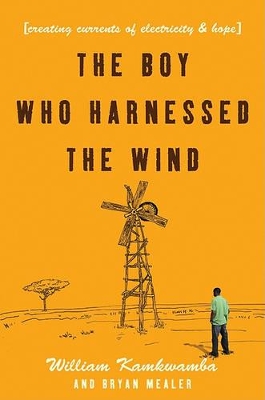This story started slow for me. I'm not a fan of detailed description of childhood in memoirs unless you were doing something very interesting as a child. Most people aren't.
The main point of this story started with a drought and subsequent famine that hit Malawi in the early 2000s. It was devastating. The author's family was no longer able to afford his school fees so he had to drop out. He wanted to continue his education so he went to a library and started to read the books there. He applied what he learned in a basic physics book to build a windmill from spare parts. This allowed his family to have lights in their house for the first time. He went on to build other windmills to pump water for irrigation and personal use, freeing up hours a day that were otherwise spent going to and from wells. He even made cell phone charging stations.
"The dynamo had given me a small taste of electricity, and that made me want to figure out how to create my own. Only 2 percent of Malawians have electricity, and this is a huge problem. Having no electricity meant no lights, which meant I could never do anything at night, such as study or finish my radio repairs, much less see the roaches, mice, and spiders that crawled the walls and floors in the dark. Once the sun goes down, and if there’s no moon, everyone stops what they’re doing, brushes their teeth, and just goes to sleep. Not at 10:00 P.M., or even nine o’clock—but seven in the evening! Who goes to bed at seven in the evening? Well, I can tell you, most of Africa."
This part of the story was interesting. He was dedicated to the idea of building his windmill but scavenging the parts took a long time. It showed a lot of ingenuity.
One strange section was about witchcraft. He reports it as fact.
"The previous famine had led to reports in the southern region that the government was banding with packs of vampires to steal people’s blood, then selling it to international aid groups."
"Following the strange beast of Dowa, many people across Malawi reported having their private parts stolen in the night, many of them waking up in the morning with their sheets bloody. Men who’d been drinking in bars were the easiest targets. As they stumbled home in the darkness, an evil creature—perhaps a gang of witch children—would pull them behind a tree and remove their parts with a knife. It was later revealed that most of the victims had been virgins, and their parts had been sold to witches, Satan worshippers, and business tycoons."
"This often happens while we sleep—the witch children can take our heads and return them before morning, all without us knowing. It’s a serious problem."
He was accused of witchcraft for making electricity from the wind. A bad storm came and the windmill was spinning rapidly. People accused him of causing storms.
This book was published in 2009. Since then William has graduated from college. He has an NGO to support community based projects around his hometown. On his webpage you can even donate to the library where he found his physics book.
This is a great story of innovation and survival.This review was originally posted on Based On A True Story
